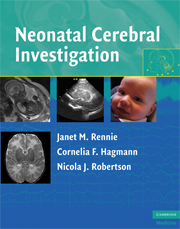Book contents
- Frontmatter
- Contents
- List of contributors
- Preface
- Acknowledgements
- Glossary and abbreviations
- Section I Physics, safety, and patient handling
- Section II Normal appearances
- 4 Normal neonatal imaging appearances
- 5 The immature brain
- 6 The normal EEG and aEEG
- Section III Solving clinical problems and interpretation of test results
- Index
- References
5 - The immature brain
from Section II - Normal appearances
Published online by Cambridge University Press: 07 December 2009
- Frontmatter
- Contents
- List of contributors
- Preface
- Acknowledgements
- Glossary and abbreviations
- Section I Physics, safety, and patient handling
- Section II Normal appearances
- 4 Normal neonatal imaging appearances
- 5 The immature brain
- 6 The normal EEG and aEEG
- Section III Solving clinical problems and interpretation of test results
- Index
- References
Summary
Introduction
The stage of development of the cerebral fissures, sulci, and gyri can give an indication of the degree of maturity of the brain. A gyrus is bounded by two sulci or one sulcus and one fissure. The most important landmarks are the parieto-occipital sulcus (sometimes termed a fissure), the lateral sulcus (Sylvian fissure) and the cingulate sulcus, but there are many others. Chi made a detailed study of 507 brains between 10 and 44 weeks' gestation in order to document the appearance and development of the major sulci and gyri [1], and we have relied on the atlas of Feess-Higgins and Larroche [2], and the more recent book by Garel [3]. The ultrasound and magnetic resonance imaging (MRI) appearances lag behind the anatomical appearances [4]; the MRI appearances lag by at least a week, with the ultrasound appearances probably taking even longer [5]. There is thus a marked difference in the literature regarding the stage at which the major sulci have been reported to appear according to whether the features were identified with MRI, ultrasound imaging, or at autopsy. The effects of gender, twinning, and intrauterine growth restriction have yet to be evaluated in any detail. We have summarized the information available from various sources in the literature in Tables 5.1 and 5.2. In general, the sulci on the medial surfaces of the hemispheres (the parieto-occipital fissure, the calcarine and cingulate sulcus) appear earlier and are easier to recognize with ultrasound than the convexity sulci.
- Type
- Chapter
- Information
- Neonatal Cerebral Investigation , pp. 66 - 82Publisher: Cambridge University PressPrint publication year: 2008
References
- 1
- Cited by

